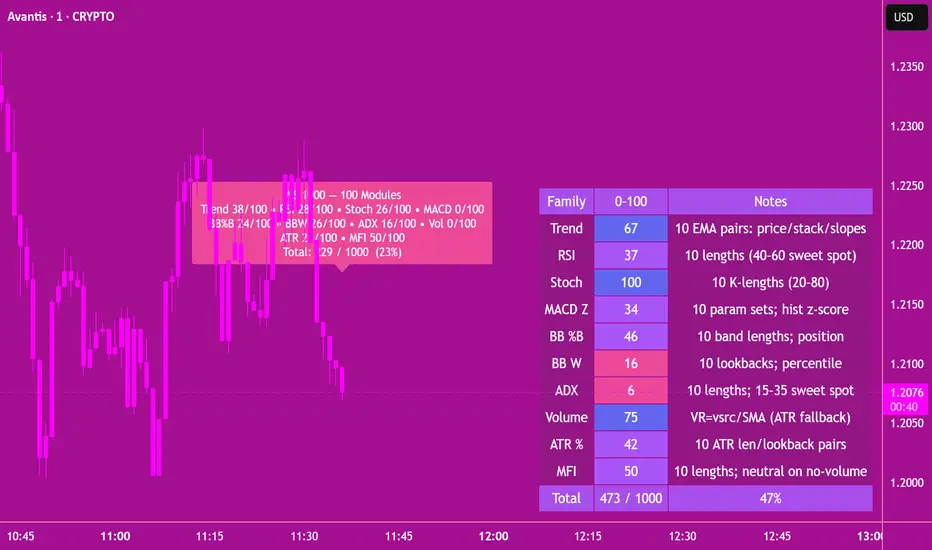OPEN-SOURCE SCRIPT
Weather Score1000,100Modules 10 Families × 10 Variants

Weather Score 1000 — 100 Modules (10×10)
A plug-n-play market “weather station” that compresses 100 popular signals into one composite grade. Ten indicator families × ten variants each → a 0–100% readiness score (with GO / NO-GO alerts), plus a mini dashboard table and a draggable badge.
What it measures
10 families (each scored 0–100):
Trend: 10 EMA fast/slow pairs (price > fast/slow, stack & slope bonus)
RSI: 10 lengths, mapped by sweet-spot normalization (40–60)
Stochastic: 10 %K lengths, normalized to 20–80
MACD Z: manual MACD (no tuple quirks) with per-set histogram z-score
BB %B: price location inside the band (10 band lengths)
BB Width: band width percentile vs lookback (10 lookbacks)
ADX: Wilder’s ADX across 10 lengths (15–35 “power zone”)
Volume Pulse: volume vs SMA as a ratio (ATR fallback if no volume)
ATR %: ATR vs its own min/max percentile (10 len/lookback pairs)
MFI: custom MFI using running sums (robust to missing volume; neutral=50)
All families are normalized, then summed. Toggle families on/off; each on contributes up to 100 points toward the composite.
Why it’s robust
No ta.sum pitfalls: MFI uses rolling sums; stable across all assets.
Manual MACD: avoids tuple re-declarations and version quirks.
ATR fallback for volume: works on symbols with missing volume.
Percentile & sweet-spot scoring: adapts to regime shifts and scale.
How to read it
Composite: 0–100% readiness.
GO alert: composite ≥ your threshold (default 80%).
NO-GO alert: composite ≤ your threshold (default 20%).
Badge: quick readout of each family’s score + totals.
Mini table: per-family color heat, short notes, and the grand total.
Signals & visuals
GO / NO-GO alerts once per bar close.
Optional painted bars (soft lime for GO, soft red for NO-GO).
Draggable badge shows current breakdown.
Customization tips
Use the family toggles to fit your style (e.g., disable BB on crypto scalps).
Tighten GO for trend-following; loosen for mean-reversion.
Lower NO-GO if you want earlier exits.
Works across timeframes; many users like 15m–4h for entries and 1D for bias.
Best practices
Treat GO as context & timing, not a blind entry. Pair with SR/structure.
Look for confluence: price above fast/slow EMAs + MACD z > 0 + ADX in 15–35 zone + BBW rising.
On illiquid assets, lean more on ATR/Trend and less on Volume/MFI.
Limitations
Needs some history to warm up long lookbacks (e.g., 300–500 bars).
On gaps or tiny sessions, width/ATR percentiles can momentarily jump.
A plug-n-play market “weather station” that compresses 100 popular signals into one composite grade. Ten indicator families × ten variants each → a 0–100% readiness score (with GO / NO-GO alerts), plus a mini dashboard table and a draggable badge.
What it measures
10 families (each scored 0–100):
Trend: 10 EMA fast/slow pairs (price > fast/slow, stack & slope bonus)
RSI: 10 lengths, mapped by sweet-spot normalization (40–60)
Stochastic: 10 %K lengths, normalized to 20–80
MACD Z: manual MACD (no tuple quirks) with per-set histogram z-score
BB %B: price location inside the band (10 band lengths)
BB Width: band width percentile vs lookback (10 lookbacks)
ADX: Wilder’s ADX across 10 lengths (15–35 “power zone”)
Volume Pulse: volume vs SMA as a ratio (ATR fallback if no volume)
ATR %: ATR vs its own min/max percentile (10 len/lookback pairs)
MFI: custom MFI using running sums (robust to missing volume; neutral=50)
All families are normalized, then summed. Toggle families on/off; each on contributes up to 100 points toward the composite.
Why it’s robust
No ta.sum pitfalls: MFI uses rolling sums; stable across all assets.
Manual MACD: avoids tuple re-declarations and version quirks.
ATR fallback for volume: works on symbols with missing volume.
Percentile & sweet-spot scoring: adapts to regime shifts and scale.
How to read it
Composite: 0–100% readiness.
GO alert: composite ≥ your threshold (default 80%).
NO-GO alert: composite ≤ your threshold (default 20%).
Badge: quick readout of each family’s score + totals.
Mini table: per-family color heat, short notes, and the grand total.
Signals & visuals
GO / NO-GO alerts once per bar close.
Optional painted bars (soft lime for GO, soft red for NO-GO).
Draggable badge shows current breakdown.
Customization tips
Use the family toggles to fit your style (e.g., disable BB on crypto scalps).
Tighten GO for trend-following; loosen for mean-reversion.
Lower NO-GO if you want earlier exits.
Works across timeframes; many users like 15m–4h for entries and 1D for bias.
Best practices
Treat GO as context & timing, not a blind entry. Pair with SR/structure.
Look for confluence: price above fast/slow EMAs + MACD z > 0 + ADX in 15–35 zone + BBW rising.
On illiquid assets, lean more on ATR/Trend and less on Volume/MFI.
Limitations
Needs some history to warm up long lookbacks (e.g., 300–500 bars).
On gaps or tiny sessions, width/ATR percentiles can momentarily jump.
开源脚本
本着TradingView的真正精神,此脚本的创建者将其开源,以便交易者可以查看和验证其功能。向作者致敬!虽然您可以免费使用它,但请记住,重新发布代码必须遵守我们的网站规则。
免责声明
这些信息和出版物并不意味着也不构成TradingView提供或认可的金融、投资、交易或其它类型的建议或背书。请在使用条款阅读更多信息。
开源脚本
本着TradingView的真正精神,此脚本的创建者将其开源,以便交易者可以查看和验证其功能。向作者致敬!虽然您可以免费使用它,但请记住,重新发布代码必须遵守我们的网站规则。
免责声明
这些信息和出版物并不意味着也不构成TradingView提供或认可的金融、投资、交易或其它类型的建议或背书。请在使用条款阅读更多信息。